I am having fun reading and replying to many of the comments on your best bird of the last week. Merlin experiences seemed to dominate last weeks comments, but Russ telling us about his Olive-sided Flycatcher experience and reports from around the country continue to be fun to see.
I went camping at Fort Flagler SP last week, and a distant FOY Heermann’s gull seen along with Black Oystercatchers has to be my favorite. How about you. Leave a comment with your best bird of the last week. Good birding!
Author Archives: admin
Best Bird of the Last Week: 6-29-2020
Another week of relative social distancing and mostly missing birding with friends. I did venture down to Wahkiakum County to visit Alcyon Farm and Andrew Emlen, get out birding and record a Bird Banter episode with him. What a cool and incredibly interesting and ecelectic guy. Check out the Skamokawa Swamp Opera band he plays in. I’ll include a You Tube video here for kicks. My best bird there was Yellow-breasted Chat. Two singing males actually. How about you? Leave a comment and help us all stay in touch. Ed
How cool is this. Singing birders. Swamp Opera???
Best Bird of the Last Week: 6-22-2020
I have really been enjoying reading about our members best bird of the last week. Mid June is here, the songbirds are a bit less vocal, the young are starting to fledge more and more. My best bird of the week was really 3 birds. Marian and I made a quick stop at the Goodell Creek Bridge on Hwy 20 on our way back home from a camping trip near Winthrop. Immediately on stopping and looing upstream over the creek I saw three different sized pointy-winged birds. Tiny twittering Vaux Swifts, much larger languid wingbeat Common Nighthawks, and in between in size, with more soaring and less twittery flight were Black Swifts. Just a really nice trio to watch feeding together. How about you? Leave a comment with your best bird of the last week.
Ed
Best Bird of the last 2 Weeks
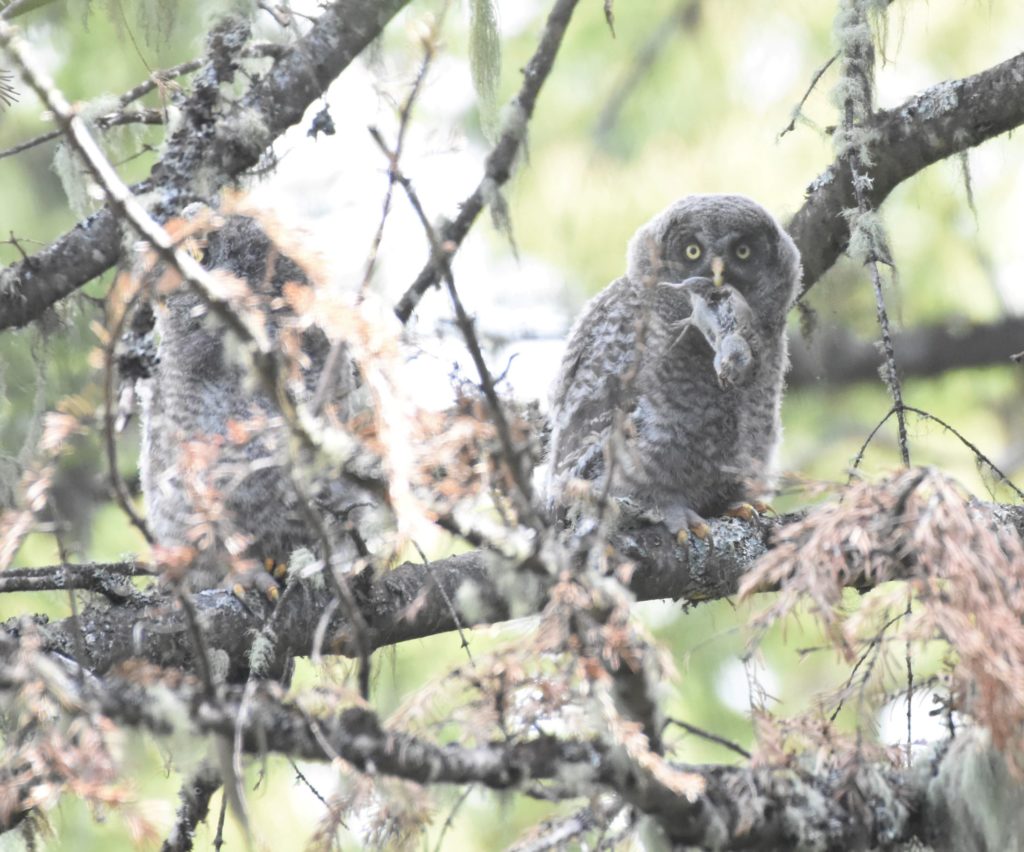
I missed last week in getting this post up, so you get to tell about your best bird of the last 2 weeks. For me, no doubt. Great Gray Owl! Mike Denny showed Ken and me a known area, we watched the owlets branching and being fed by an adult, and the three of us sat by the side of an old logging road and recorded an episode of The Bird Banter Podcast. An incredible experience. I wrote a trip report on the blog here for anyone interested in photos and the whole 3-day story.
What was your best bird, or birding experience of the last 2 weeks. Share by leaving a comment on this post. I’ll try to approve quickly. By the way, some birding walks are reopening. The Theler walk with Fay and others is on for this Thursday, and Scott had a walk today at Ft. Steilacoom Park.
Westport Seabirds is opening some trips for the summer and fall. Birding in small groups with social distancing seems to be opening back up to a limited degree. Stay safe, but have fun.
Ed
Best Bird of the Week: 5/25
This is a place to stay connected with your birding friends, talk birding, and let the rest of us know you are still birding and doing well. Post the “best” bird you saw in the last week, tell us why you chose this bird, and tell a story if you like.
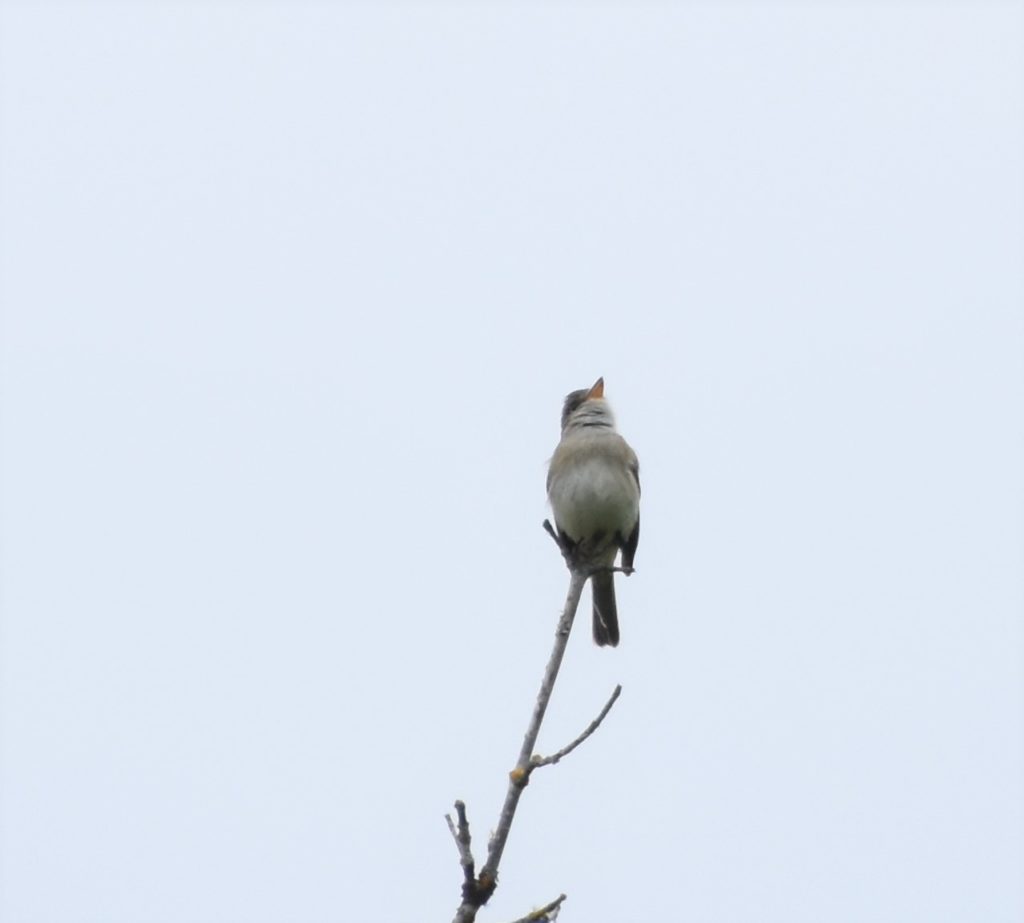
For me the best bird of the week was not the Franklin’s Gull that somehow Charlie Wright saw way out on Commencement Bay from the gravel lot up on top of the Dune’s Peninsula area. It was the Parasitic Jaeger that I found myself from Iverson Beach on Camano Island. Marian and I went up Sunday to visit her sister, have a socially distant visit on their deck, and before meeting them birded the Iverson Beach area. When I got there several Caspian Terns were squawking and flying around, so I thought, why not a jaeger? Very few birds were out on the water, and one of the first floating birds I saw had the jaeger profile. I zoomed up the scope and sure enough, an adult Parasitic Jaeger. It subsequently did its tail-chase thing with the terns, even more diagnostic of it’s ID with the white wing flashes, pointy wings, and behavior. No photo, way too far away. The location is really cool though, with a dike walk, a forest trail, and a walk back through a marsh with a “Hobbit Trail” that was unexpected. I now don’t have to wait for a possibly “not-happening” pelagic trip or the fall migration for my PAJA this year. Good birding. Leave your best bird notes in the comment section. Thanks.
Also if you listen to The Bird Banter Podcast, help me out and leave a rating and review on the podcast feed of your choice. It helps me out with feedback, and better ratings on the podcast feed platforms.
Good birding.
TAS Birdathon In Full Flight
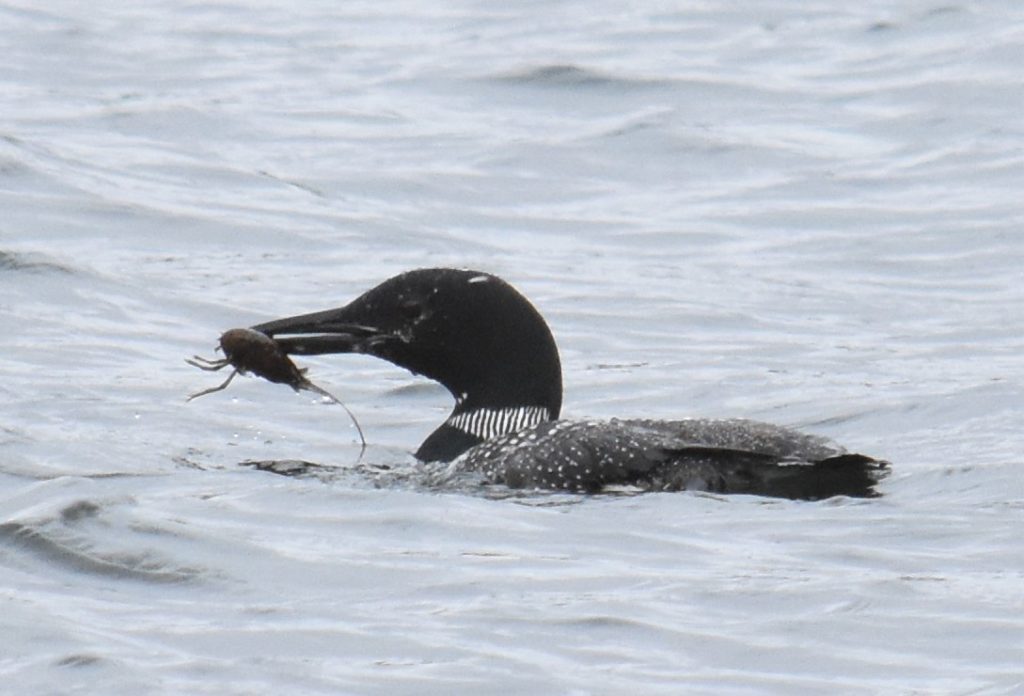
Now is a perfect time to go to the TAS page and set up your birdathon page, or if you are not doing your own fund raising Birdathon then to donate to one of the other TAS birders who has a page set up there Several of our ABCers have pages including myself, Diane, Heather V. , Heather & Marcus, Art and Nathanael. Here is the link to choose which effort to use to support the effort. Thanks in advance. Ed Pullen
https://secure.givelively.org/donate/tahoma-audubon-society/birdathon-2020
Best Bird of the Last Week 5-18-2020
This is intended as a way to let us stay more in touch through this time with less opportunity to get together in person. I encourage everyone who wishes to share their best bird sighting/find of the past week in the comments section below. All you need to do is click on the little Talk bubble symbol beside the title, leave your comment, and I’ll review for spam and it will be live. I believe once I’ve approved one of your comments, the rest will get up without my manual approval. Sorry about the delay in approving some of the comments. I got busy birding!
Last week in comments grosbeaks ruled, with both Evening and Black-headed Grosbeaks getting multiple votes.
This week as another great week of migration. Ken and I got east of the Cascades Friday and Saturday, and it’s hard to say which of the 26 FOY birds was my best. I guess I’ll go with the calling Flammulated Owl that was calling at the same time as a Western Screech Owl and Common Poorwills up Dry Creek Rd out of Wenas Creek Campground Friday night.
You can read about our trip here: http://birdbanter.com/index.php/2020/05/18/ken-and-ed-get-east-may-15-16-2020/
You will also find a link to the latest Bird Banter Podcast episode with Nate Swick of the ABA there too so you will be entertained while you drive to your next birding stop.
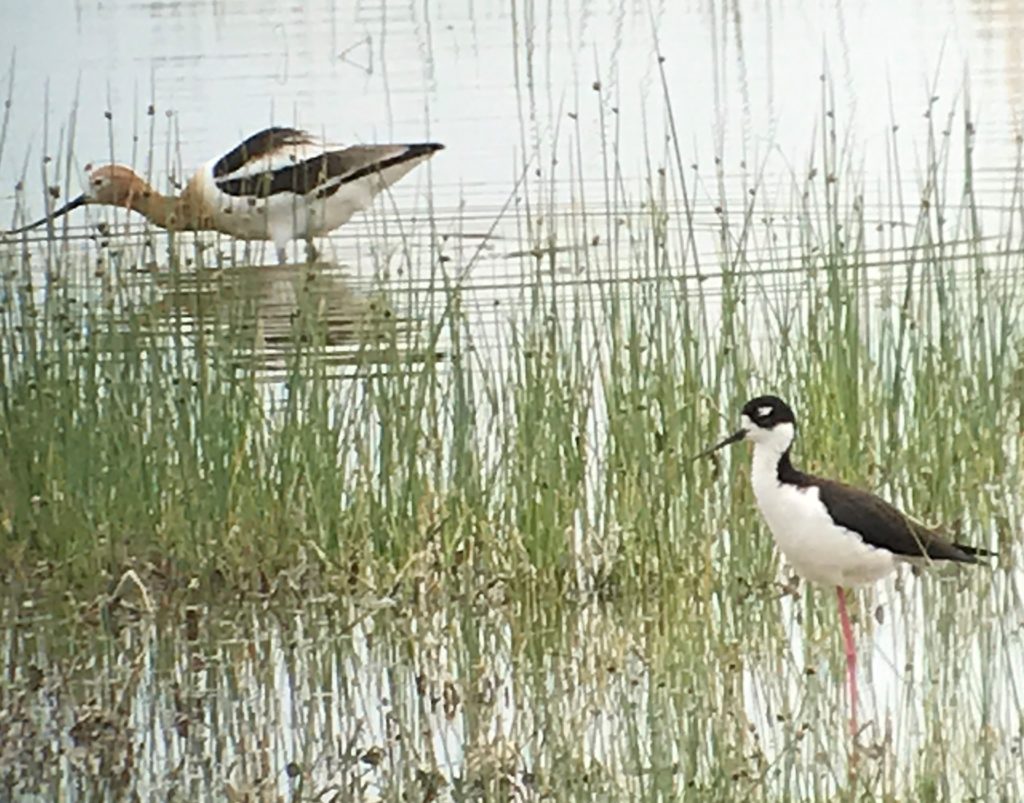
Good birding.
Ed
Best Bird of the Past Week
This is intended as a way to let us stay more in touch through this time with less opportunity to get together in person. I encourage everyone who wishes to share their best bird sighting/find of the past week in the comments section below. All you need to do is click on the little Talk bubble symbol beside the title, leave your comment, and I’ll review for spam and it will be live.
For me the best bird of the last week was a Sora. Will, Bruce, Peter and I did a Pierce County Big Day (also my birdathon) and while scoping for ducks and shorebirds at the Mountainview Cemetery Marsh a Sora called loudly and all four of us shouted “SORA” almost in unison. How about the rest of you ABCer’s?
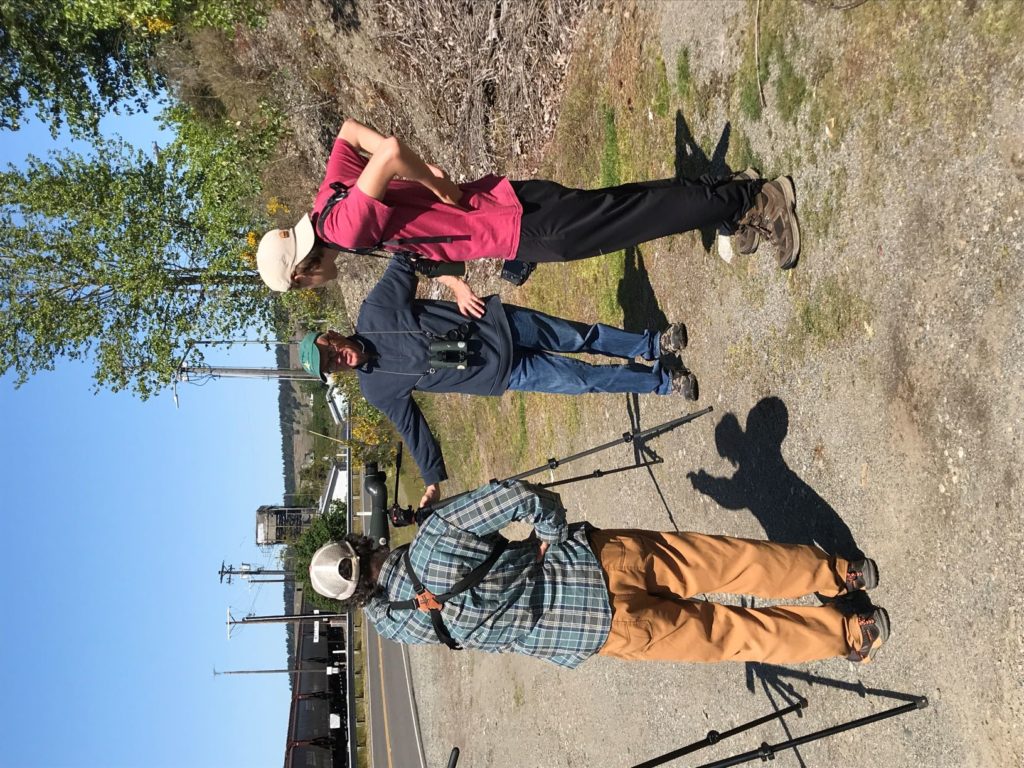
ABC Field Trip to the Lower Rio Grande Valley Feb 2020.
ABC RGV Birding Trip
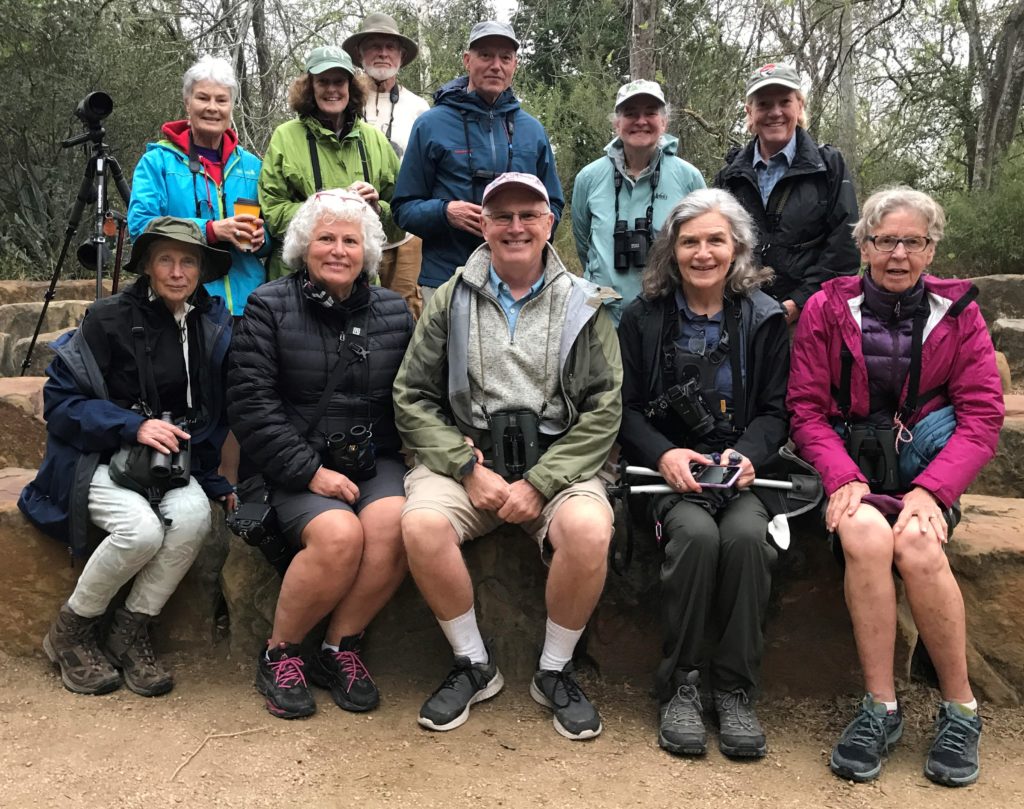
I was a little nervous when I volunteered to lead a group of ABC Birding Club birders on a 6-day birding trip in the Lower Rio Grande Valley of Texas. My previous birding trip leading experience was mostly as Ken Brown’s assistant, and on local one day or at most 2 day trips in Washington. Still, I had decided to spend a month in the valley, and figured that with the first part of the trip spent birding with Ken Brown and Bruce LaBar (hear about this on our podcast episode here), I’d be confident enough to make it work out. When the group filled with mostly birders I knew from the club it seemed OK, then three more signed up that I had not birded with previously adding an unknown variable to the mix. You can read my trip report of the time with Ken and Bruce here. and here and here.
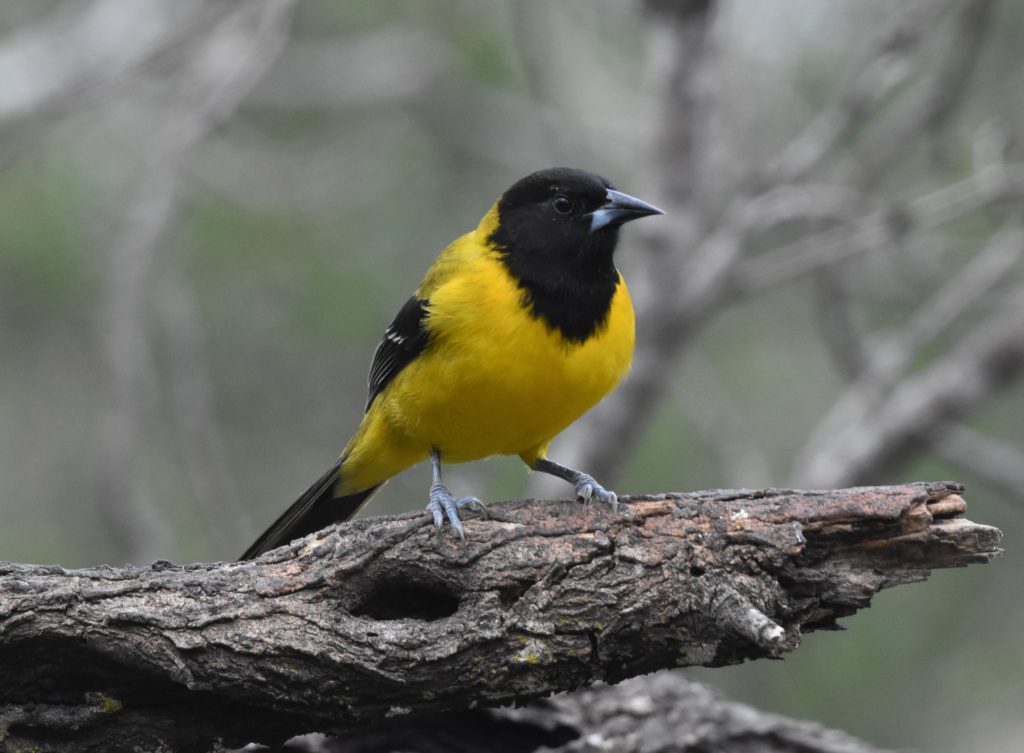
Well, it worked out just fine. On Feb 3 several of the ABC participants got notification from their airline that extreme weather expected in Dallas might delay or postpone their flights planned for Feb 5th, and so they rebooked flights for Feb 4th. This added a bonus day to the planned week-long visit with 7 of the 10 getting the early flight. All arrived about 8 PM on the 4th, and Richard, Mary and Steve came to stay in the extra rooms at my Airbnb, while Kay, Kathy, Ellen, and Susan went off to La Quinta(s) for the night. The first two nights there were two different hotels due to booking confusion, but by night 3 that was consolidated to simplify getting each day started.

For the bonus day I took the group west in hopes of finding a flock of Red-billed Pigeons, yes 13 Red-billed Pigeons, that had been seen at Chapeño the afternoon prior. While I was there Fred Matthei called to let me know he had the flu, and wouldn’t be able to join us that day, reducing the trip to 11 members. The day turned out to be a very cold and windy day, with temps barely breaking 50, and strong winds. None of us were dressed for the weather, and overall the birds were laying low. Still, we managed to see good birds and have fun. No pigeons to be found, but we explored the old El Rio RV Park at Chapeño where many years ago Ken Brown, myself and a group had found the Brown Jays that flew across the Rio Grande each morning to feed on dog food placed on a platform there. Birding was slow, but everyone got their first look at Mexico across the river.
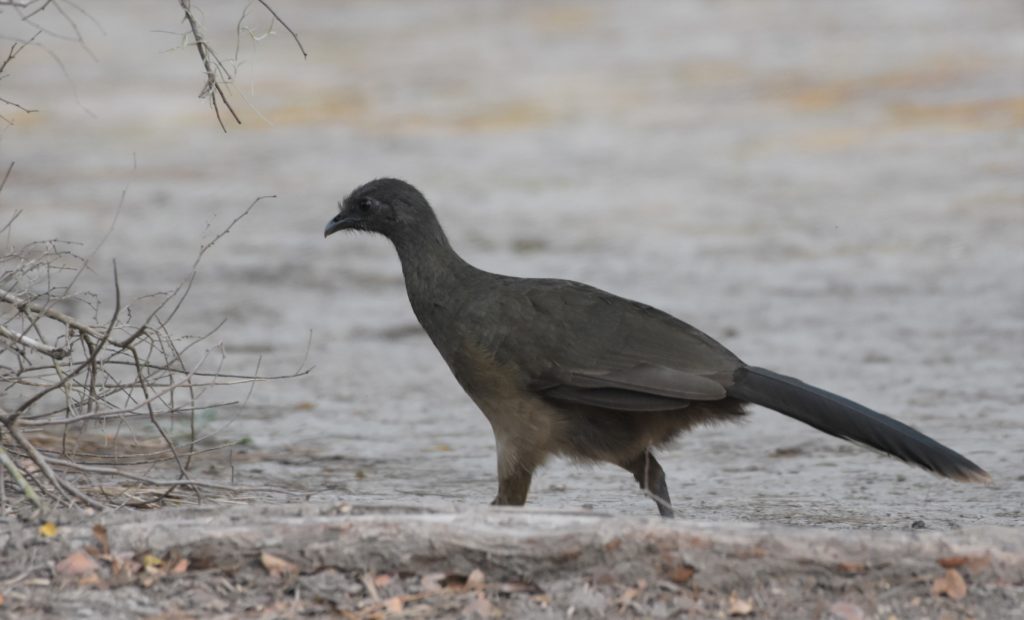
From there we went to Salineño, where IMHO the best feeding station in the valley is kept up by winter visitor volunteers who have been coming every winter for over a decade. A pair of Audubon’s Orioles gave great looks, Greater Roadrunners, Plain Chachalacas, Green Jays, Great Kiskadees, Olive Sparrows, Ladder-backed and Golden-fronted Woodpeckers, White-tipped Doves and more gave most of the group lifers and a feel for the special birds of the area. We tried along the river but no seedeater.
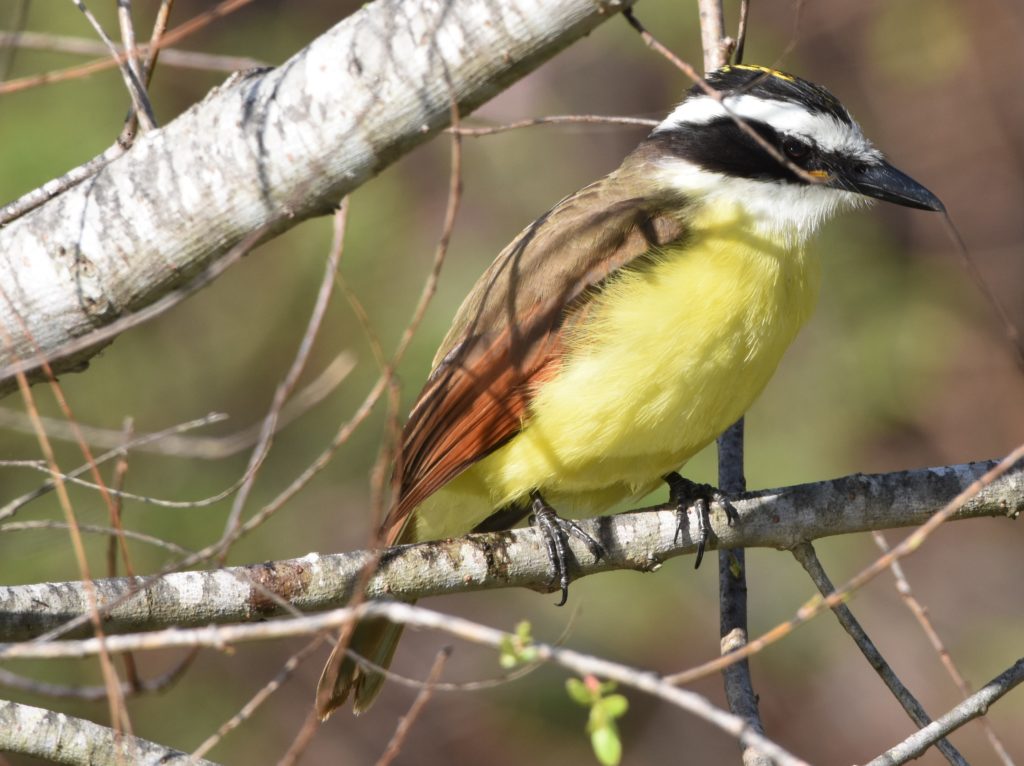
Falcon State Park so windy and cold, with the feeder station empty, that we struck out there completely. I did show them a skeleton of a marshmallow as a hint of their use there to attract Orange-crowned Warblers and more.
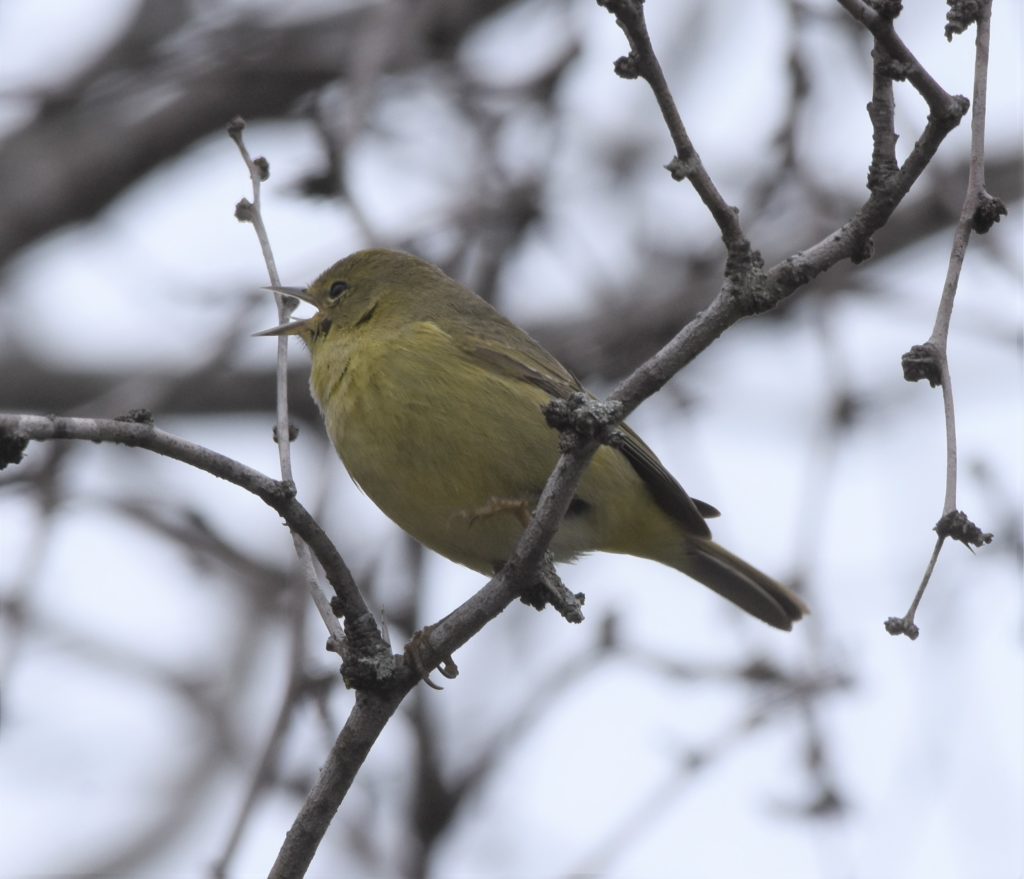
That night Edie and Jodie arrived to complete the group and the next morning we headed to Estero Llane Grande, where as is usual this fabulous area gave good looks at many waterfowl, waders and a few passerines. The water level was higher than the earlier trips there and very few shorebirds were found. That afternoon we tried for the Fork-tailed Flycatcher in Mercedes. No luck, and as it turns out the day prior was the last reported sighting as of the date I write this post. We did get to see lots of valley hawks near burning sugar cane field, with good numbers of both vultures, White-tailed, Harris and many morphs of Red-tailed Hawks. We finished the day at the Westlaco Red-crowned Parrot roost, treated to well over a hundred Red-crowned Parrots with other non-listable parrots like Yellow-headed and Red-lored scattered in the flock.
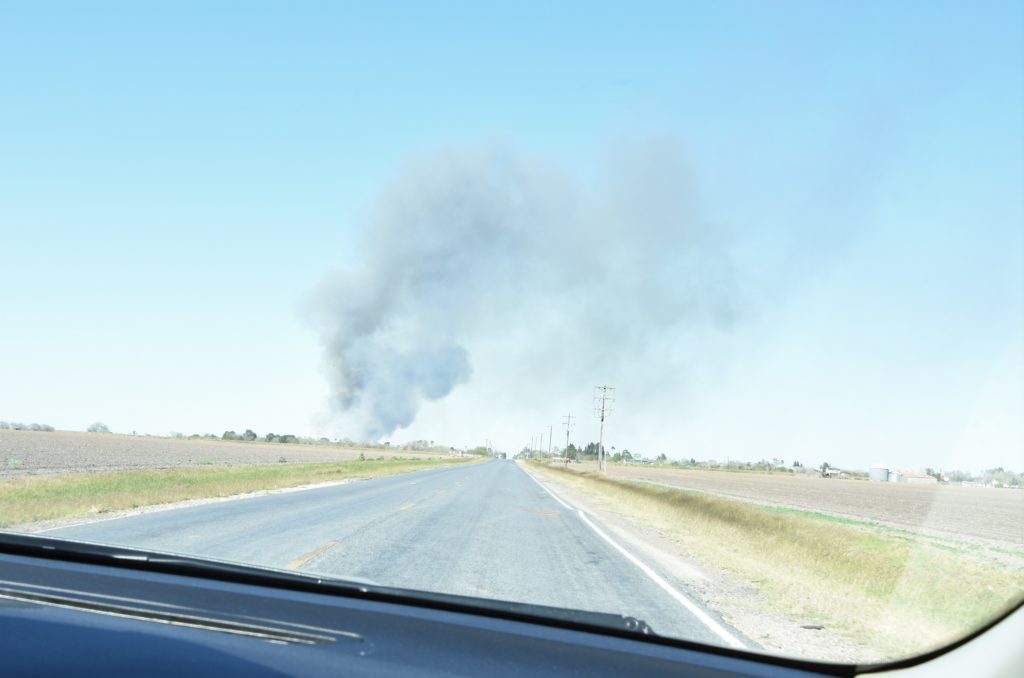
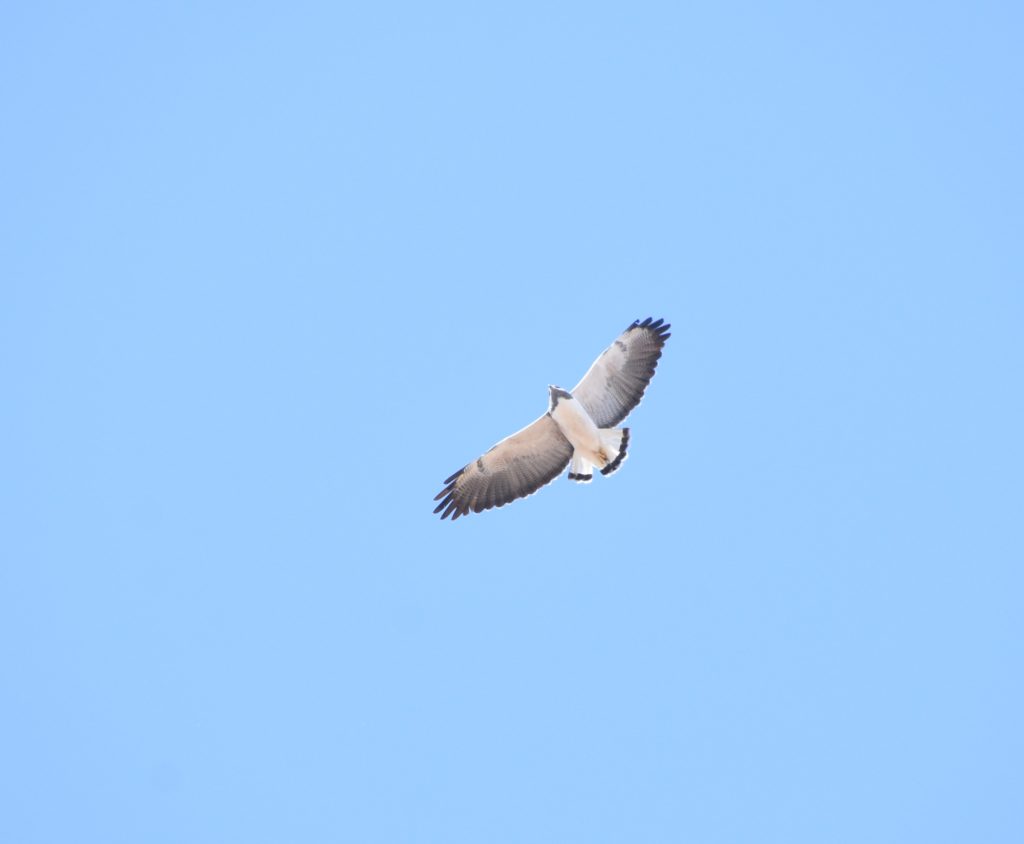
On day 2 we stayed close to home, starting at Anzalduas County Park where the field that had been so spectacular a couple weeks earlier for Ken, Bruce and me was fully groomed, ready to plant, and devoid of raptors except for American Kestrels. We did get glimpses of the Vesper Sparrows though, and headed for the park when it opened at 8AM. For me, one of the trip highlights was looking for Sprague’s Pipit at Anzalduas. Ken, Bruce and I had found them in a field there, so I had that experience in finding them, but it was really fun to line the 11 of us up across half of the big field. The grass had been mowed shorter, making it easier to see birds, and after just a short in-line-formation walk we flushed several pipits. I had everyone stay put, got close, got them in the scope, and the group slowly came up for great close-up looks. The birds were very cooperative, and we spent a half hour stalking them slowly to get closer and closer looks. This is a tough to find bird, hard on their northern prairie breeding grounds and generally secretive and camouflaged so everyone was happy to get them, and it got the trip off to a splendid start. Also at the park we saw the unusual for south TX Rock Wren, House Finch (very local in S TX), and lots of other birds.
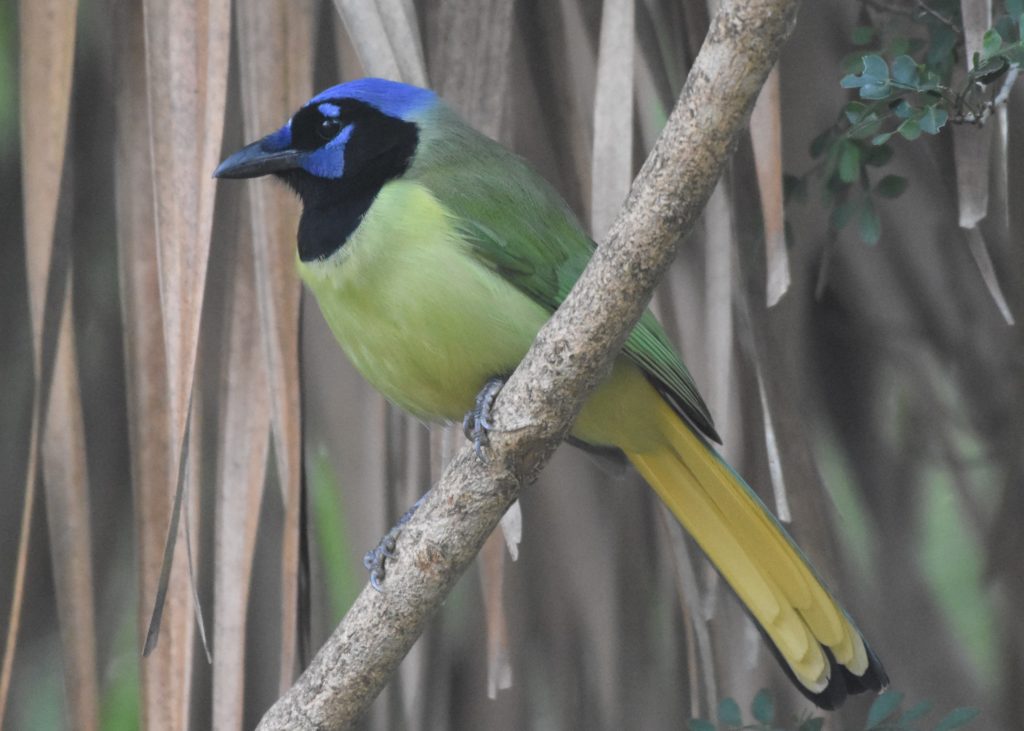
Next we birded the National Butterfly Center where we had lunch and saw the resident McColls sub-species of Eastern Screech Owl.
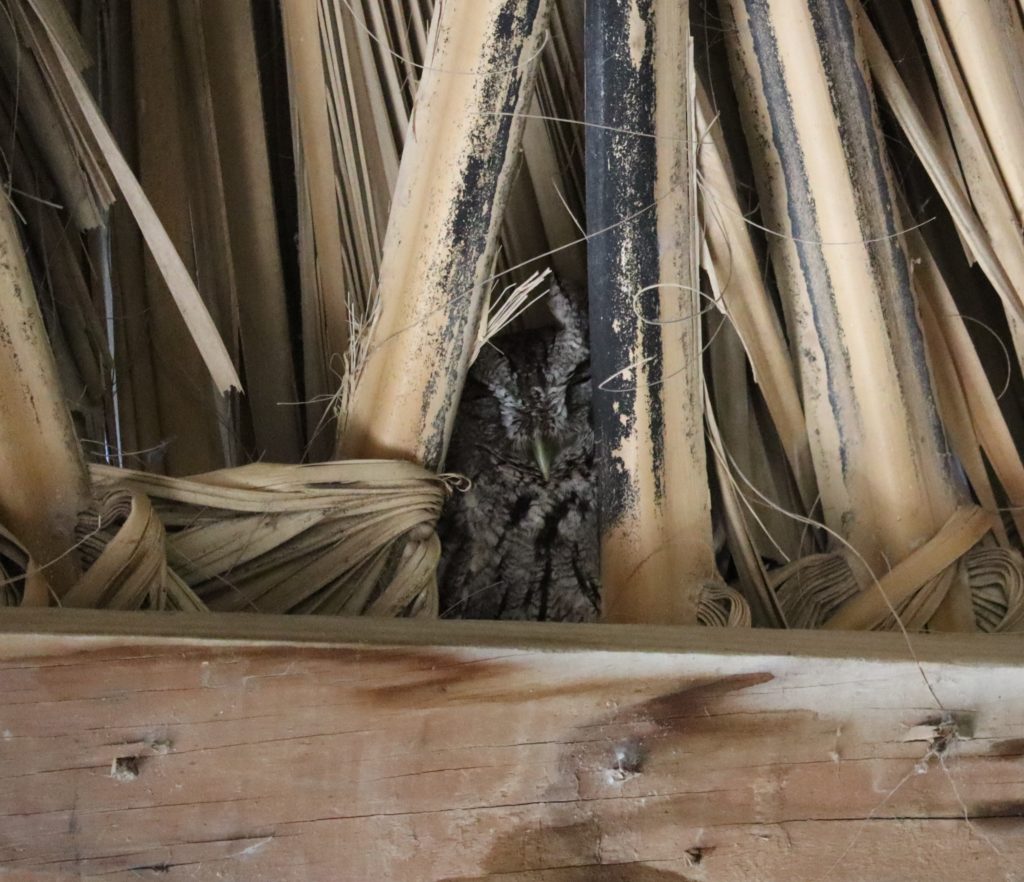
The day prior at Bentson Rio Grande State Park a female Rose-throated Becard had been seen. We headed there for a try. This is a huge park, but it was seen between feeders #3 and #4, so after looking around the gardens near the center HQ we walked there. Most of the group was beat by then, and took a tram ride around the park. Several of us stayed to try for the Becard. I sat Marian and Steve at station 4, I went to station 3, and Mary stayed part way between. It was hot, and birding was slow. Steve, as was his usual modus-operandi, decided to take a walk down to the river. Just after he got up to head that way a bird flew right across the road in front of him. He got on it and it was the Becard. He was maybe 200 yards from me at the time. Fred called about that time to let me know he would not be coming mid-week, and Steve phoned Mary to try to get us all on the bird. Mary grabbed me, and I ran the distance to the bird. At least one other birder not in our group knew a running old man with binos and a camera must mean a great bird so he ran behind me. I got there along with Mary and we got the bird pretty quickly. It posed beautifully for photos and then flew into the brush. The rest of the group got back on the tram about then, and I managed to walk around to a different path and relocate the bird for everyone. Another trip highlight for all but Richard who stayed back at HQ to avoid a painful long walk.
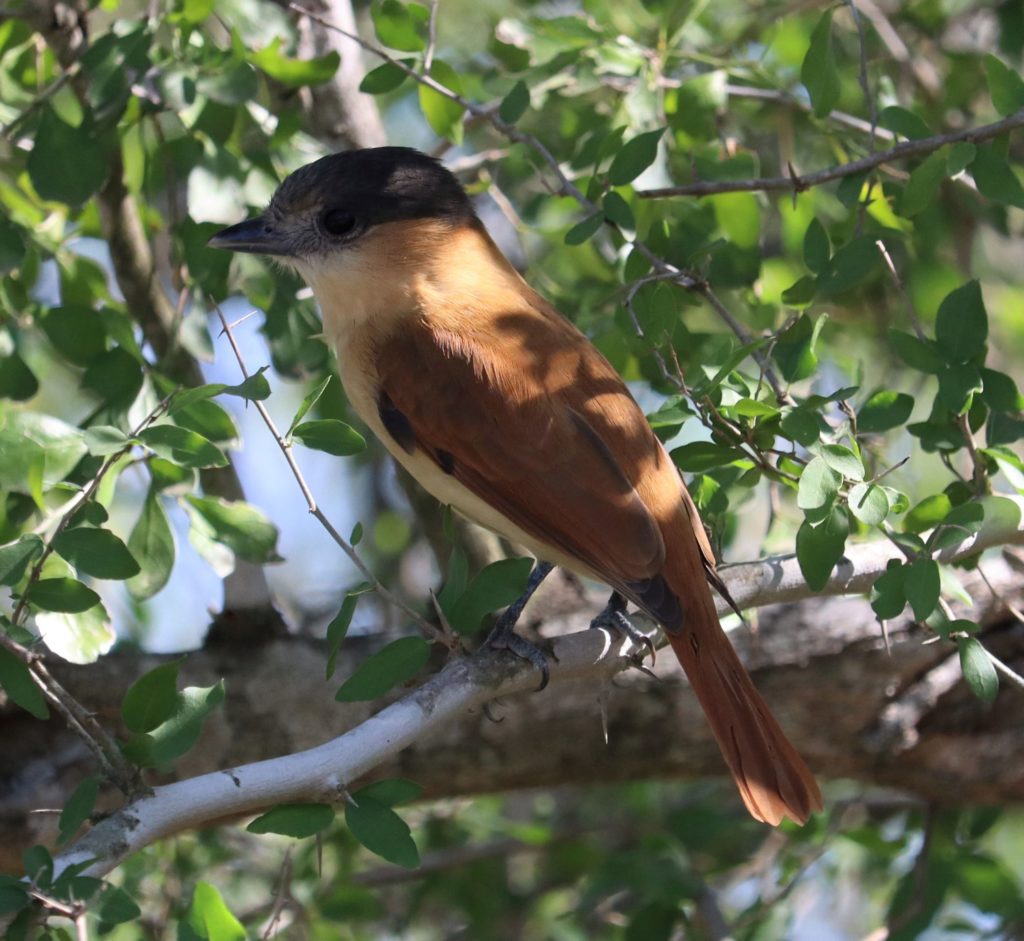
On the way home we tried for the Burrowing Owl and Granjero, no luck, but did find the Monk Parakeets near their roost at Hidalgo. We finished the day for dinner at the Chipoltle in McAllen literally underneath the big Green Parakeet roost site. Lots of lifers all around. I was beginning to worry that the rest of the trip would be impossible to meet the expectations being set by the first 2 days.
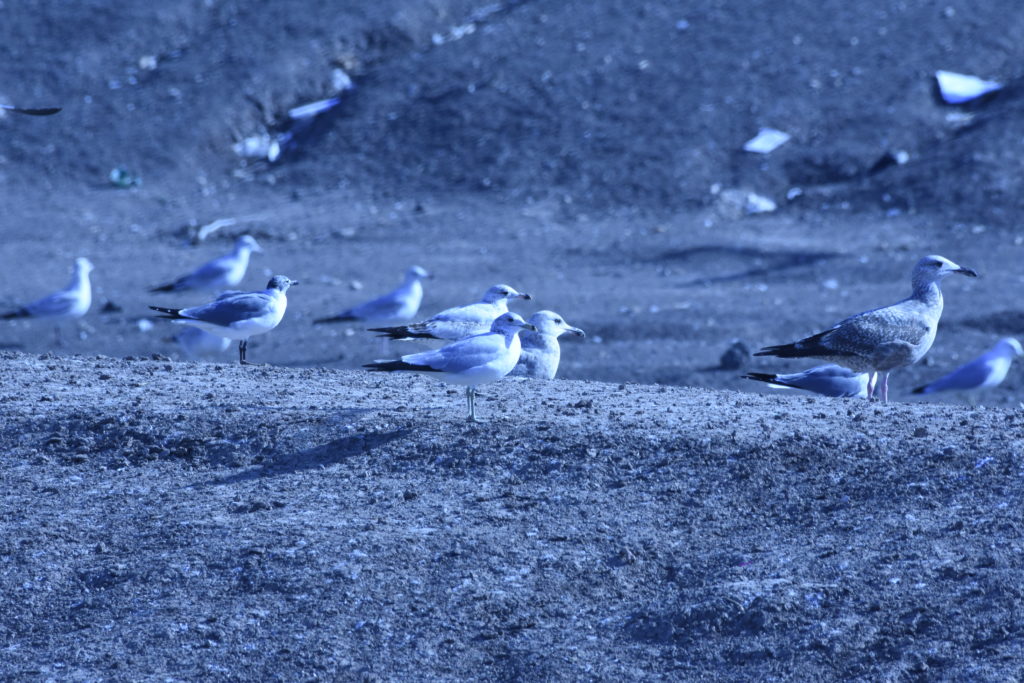
We decided to make day 3 a bigger driving day. We headed for the Brownsville Dump, a place famous mostly as the ABA place for Tamaulipas Crow, not seen in recent years, but our visit was really for the spectacle. Thousands of gulls, vultures, blackbirds, cowbirds, Cattle Egret, and at least one Chihuahuan Raven. I managed to find an adult Lesser Black-backed Gull, which before I could share the scope was obscured by a bulldozer not to be relocated. Jody and Edie thought they picked a Zone-tailed Hawk out of the flock of vultures for just a second but we could not relocate it.
Next was an unsuccessful try for Common Black Hawk at the Univ. Texas RGV Campus in Brownsville. A cool campus, fun to see, but a quick try yielde rpm there d no COBH.
From there we headed to Rte 100 and the Aplomado Falcon viewing area. Everyone got great looks at two falcons roosting on the hacking platform, and at the great photos on the phone of a professional photographer of the Hook-billed Kites he’d seen an photographed that AM at Santa Ana NWR.
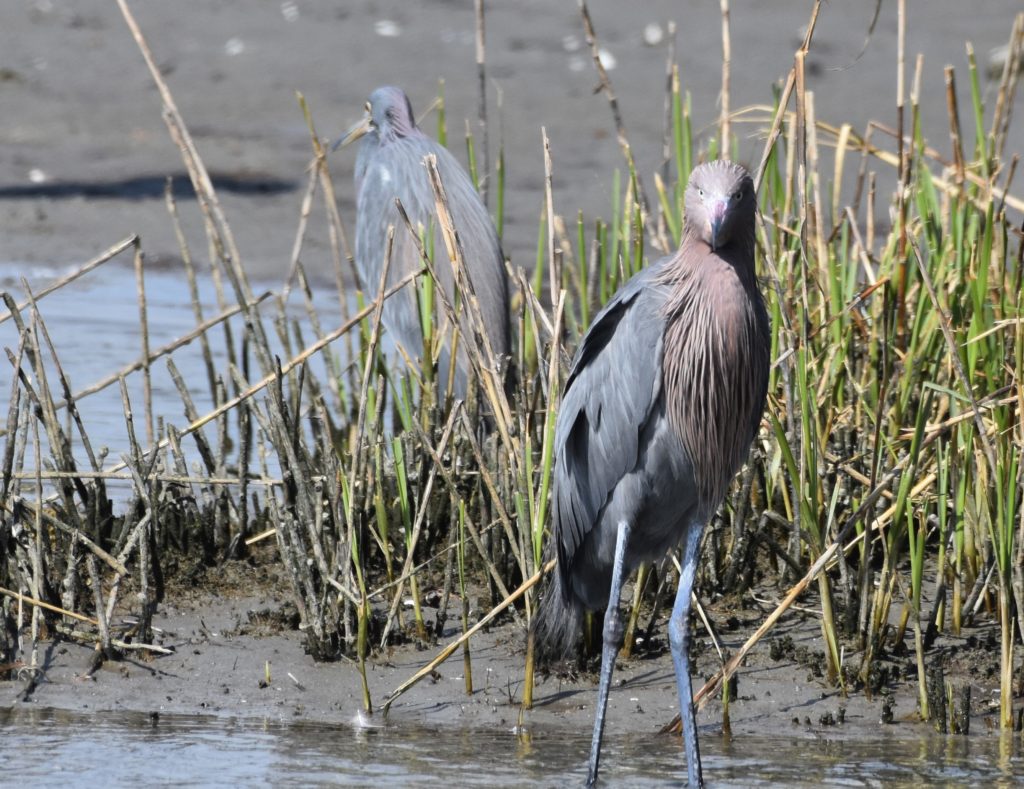
From there we headed to S. Padre Island and the Birding and Nature Center there. Everyone saw Bid Padre, the alligator there, along with great looks at all the waders on an incoming tide. Everything was really close, in great light, and we all ogled the birds there. Black Skimmers were working and roosting, at least 2 Reddish Egrets were very close to the boardwalk, and Steve located two tan birds hiding in the reeds like American Bittern are prone to do. He called them bitterns, and I looked quickly and agreed. I took a cool video of the birds, posted it to Facebook, and quickly got excellent feed back that the two juvenile Black-crowned Night Herons were fun to look at. Egg on my face, and lesson learned. Look carefully and critically at what I see, don’t jump to ID too quickly. Fun and educational for me.
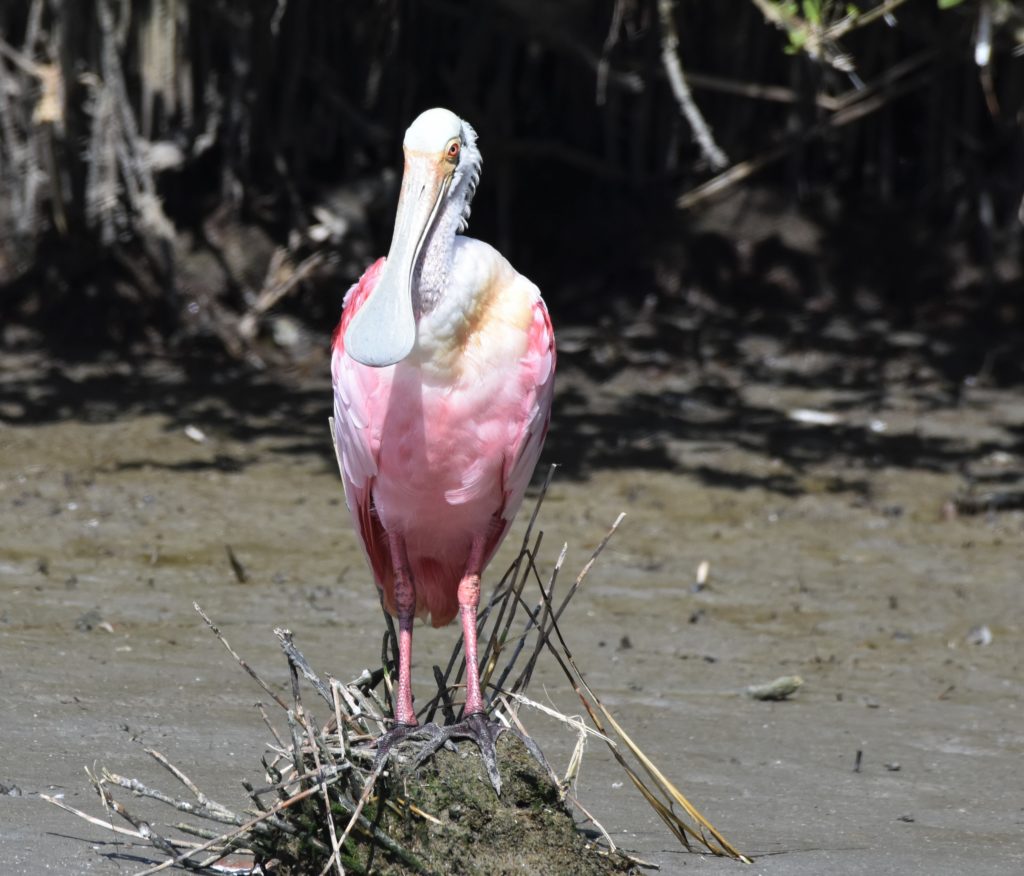
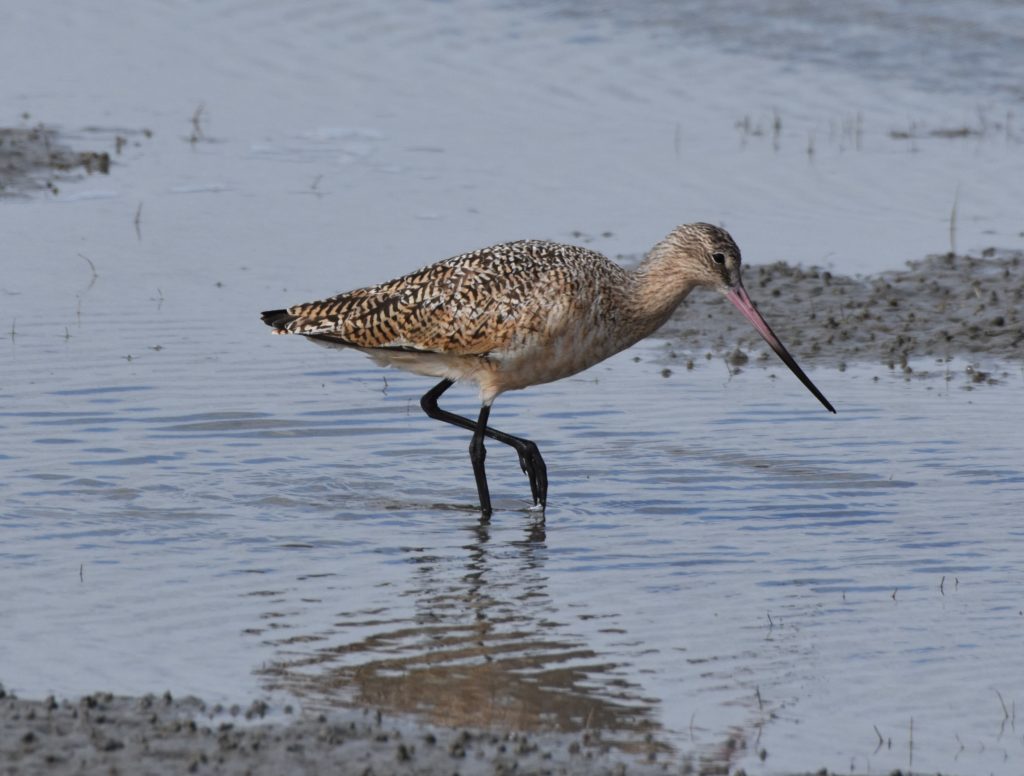

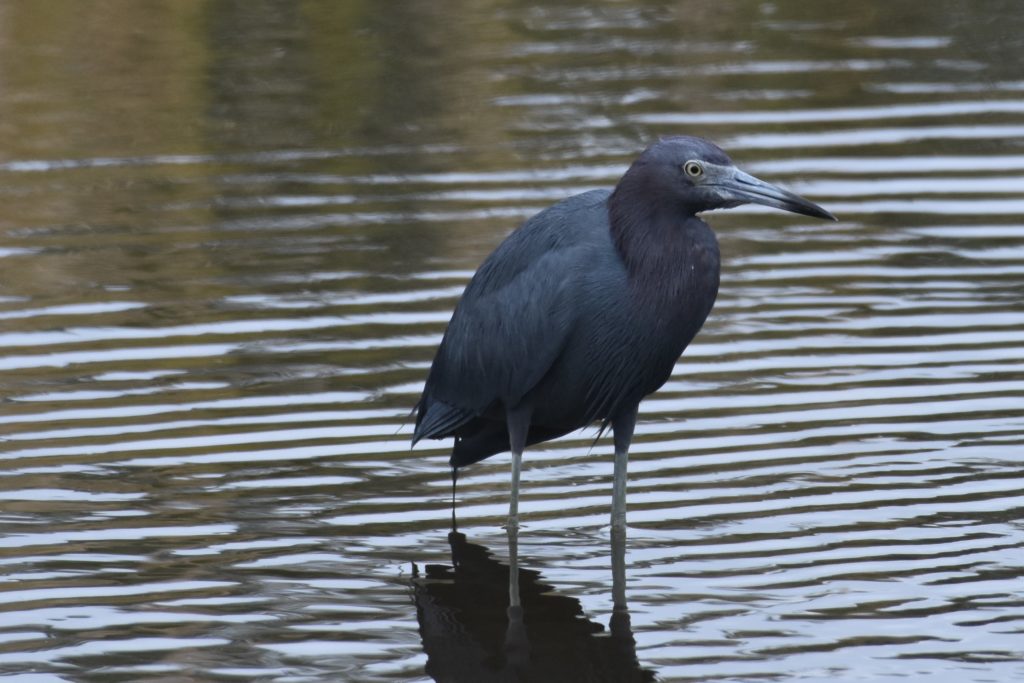
We went across the island for a quick beech stop, adding Forester’s Terns and Sanderling to our list, took a barefoot walk in the surf, and had dinner while waiting for the sun to set to avoid a long drive into a setting sun home.
Day 4 was spent north of McAllen, birding Brushline Road, the Rio Beef Feed Lots (could not get into the lots) and then Delta Lake. It was cold, windy and very slow on Brushline Rd. Hundreds of Morning Doves, lots of RWBL, and not much else were seen, Marian helped a lot by hanging back, following in the car when we walked, staying warm ;.) and taking a great photo of a Lark Sparrow we flushed but did not see which landed about 8 feet from her car window. We managed an obscured view of one later but hers was by far better.

The planned highlight of the day was to go to the Edinburg Scenic Wetlands. I had everyone excited about going, telling everyone it is my favorite place in the area. We stopped at Delta Lake for lunch, and watched a Peregrine Falcon chase both Roseate Spoonbill and an Anhinga, but again no kingfishers. When we got to the Edinburg place, it was closed on Sunday. My first big screw-up of the trip, so we settled for a walk around the Hidalgo Pump House WBC area. Not much special was seen there really, and we called it a day.
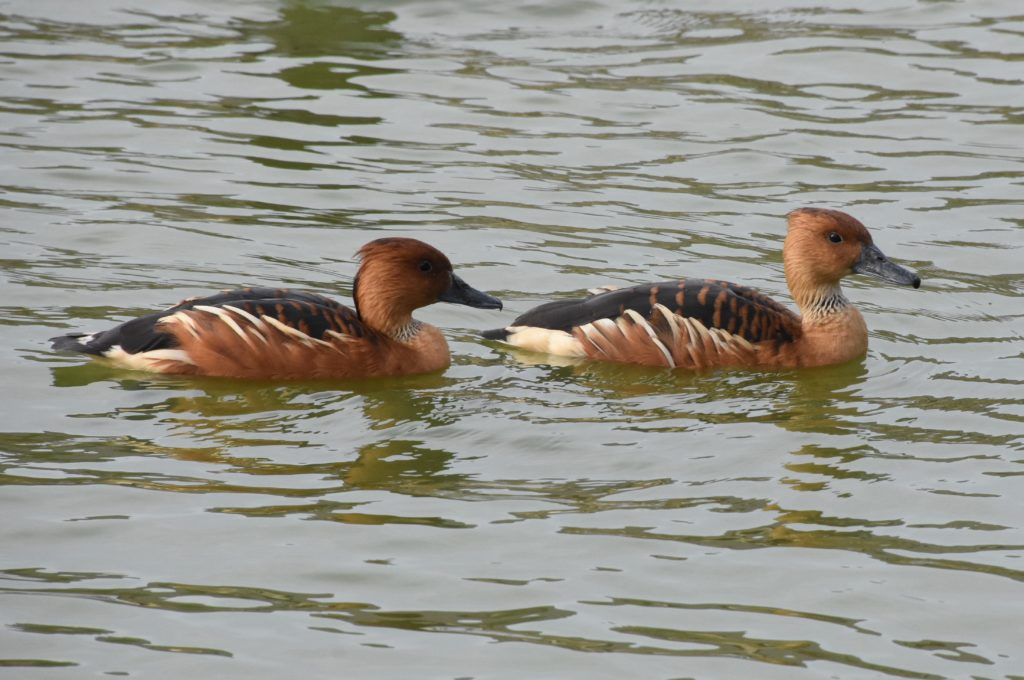
Day 5 was our day to go to Santa Ana with hopes for the Hook-billed Kites that have been seen there, and whose photos seen at the Aplomado site had everyone hopeful and excited. We checked the feeders (adding the first Clay-colored Thrush of the day for just Kathleen and Kathy). When we got to the tower, with a capacity for 10 people, there were already 8 birders on top. I took Kathleen up and we set up the scope for a look. Within minutes I found the kite, not too far away, but Kathleen on the bird, along with all the other birders (hoping it would satisfy them and they would go down so others could come up) then ran down and sent up the group two at a time. The first 2 got the bird, but before the next 2 were able to see it, the bird flew down. After a bit the others left, and we all got on top. Steve decided to explore the refuge, but shortly after I again found the bird and got everyone onto it for great looks. Some distant digi-scope photos were had, but it didn’t seem to want of fly. Other highlights of Santa Ana that day were looks at Green Kingfisher, and nice looks at the young Hooded Oriole that has been hanging out by the feeders.

We had lunch there and spent the afternoon at the Edinburg Scenic Wetlands, now open on Monday. I love this area, so easy to bird, so birdy, and near where I was staying. We added lots of great bird there. Yellow-throated, Wilson’s and Black-and-white Warblers, several Clay-colored Thrushes for everyone to see, the Audubon’s Oriole again, a Ringed Kingfisher, and lots more. A great day overall. We finished the day with a couple of easy lifers for most, Black-bellied and Ferruginous Whistling Ducks at Bannworth Park in Mission. As cool as these were a Double-crested Cormorant that swallowed a huge fish as we watched, and fighting domestic Muscovy Ducks stole the show.
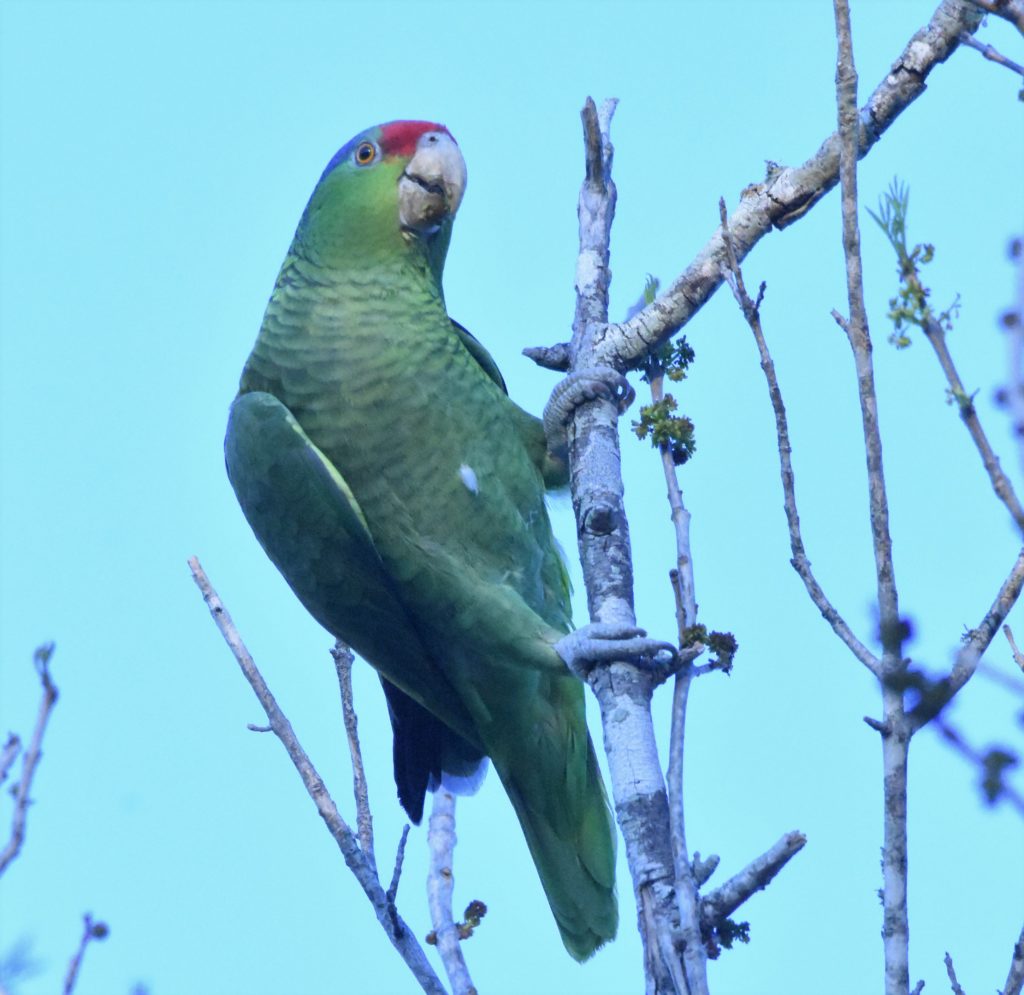
Our last day we spent going back west to Salineño and Chapeño. Again no Red-billed Pigeon, but although it was again cold, it was less windy and not as cold as our first day for the early-arriving group. Again the feeder was good, though slower than last time, but Kathy found us the seedeater. She saw a bird low in the reeds when she sat on her portable chair. I got on it and it was the male Morelet’s Seedeater. A 8 of th4 11 in the group saw it as it foraged very low, popped up for a few second perch, but flushed a long flight up river as I tried to get the others to hurry over for a look. Kathy again got looks at the bird later, but we never got the rest of the group onto the bird.
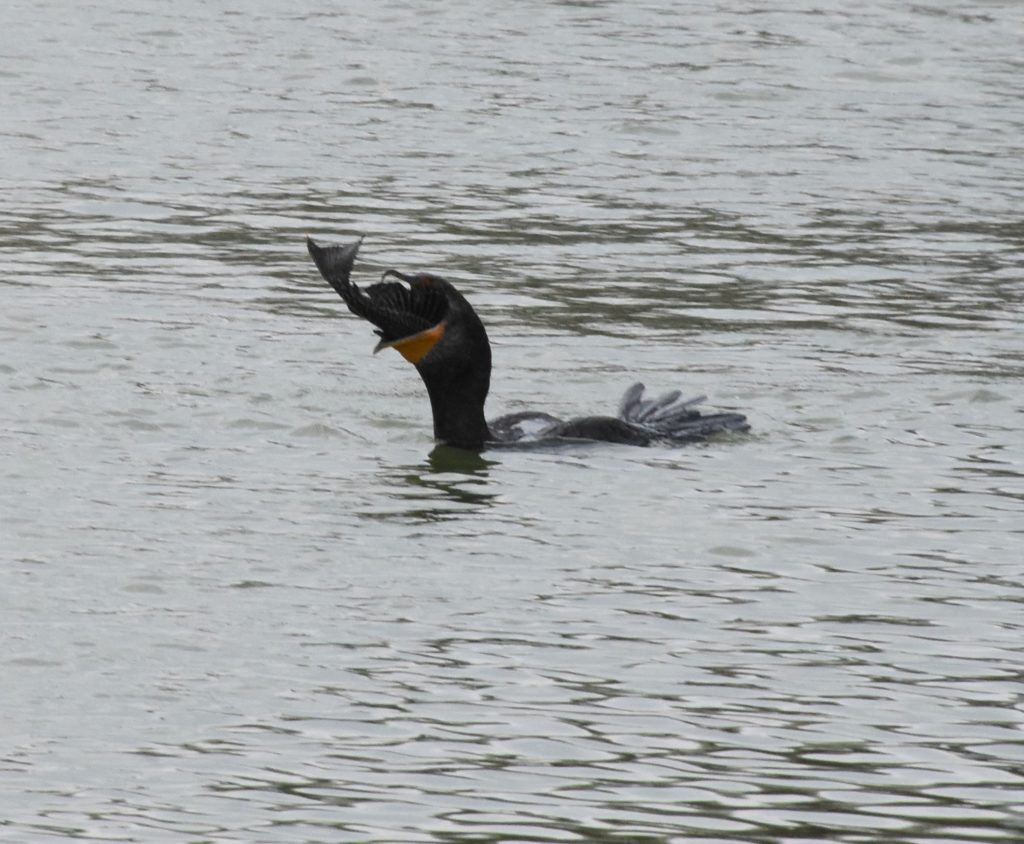
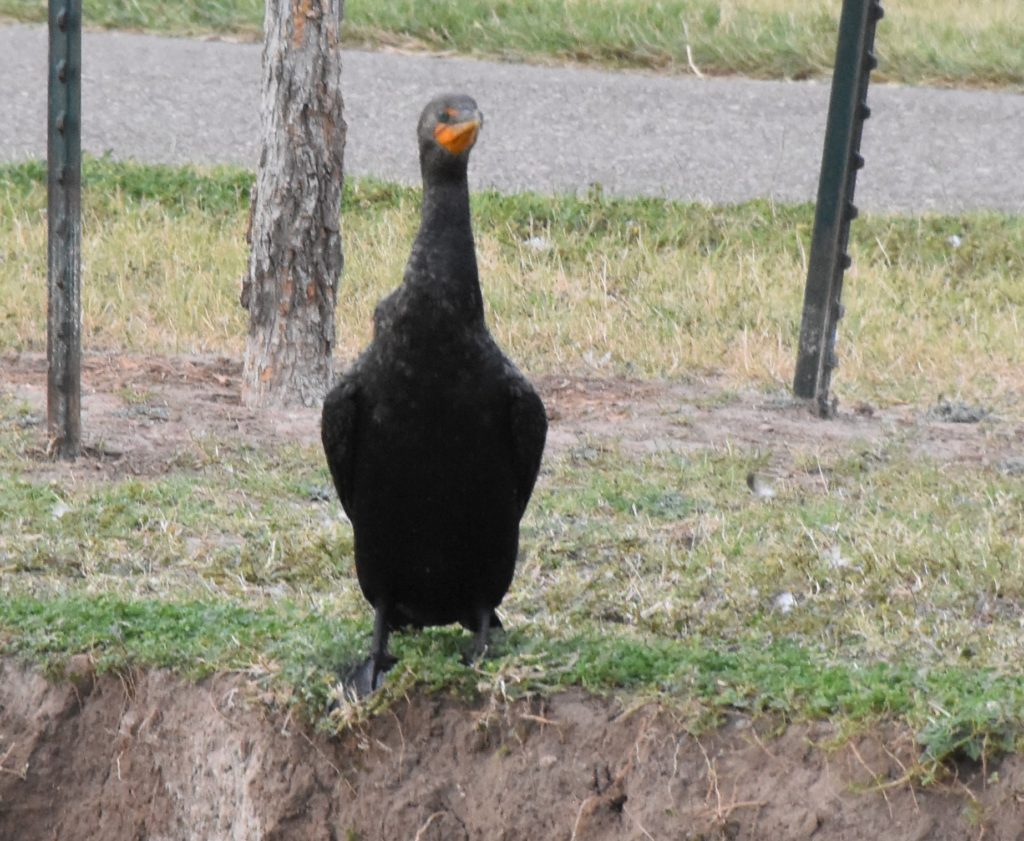
Stops at Falcon Dam State Park were not terribly fruitful, and we ended the trip with the long drive back to McAllen, and a brief stop at the urban jewel of a place, Quinta Mazatlan WBC. It is right in McAllen, and has great birding, over30 bronze sculptures, and a rich history.
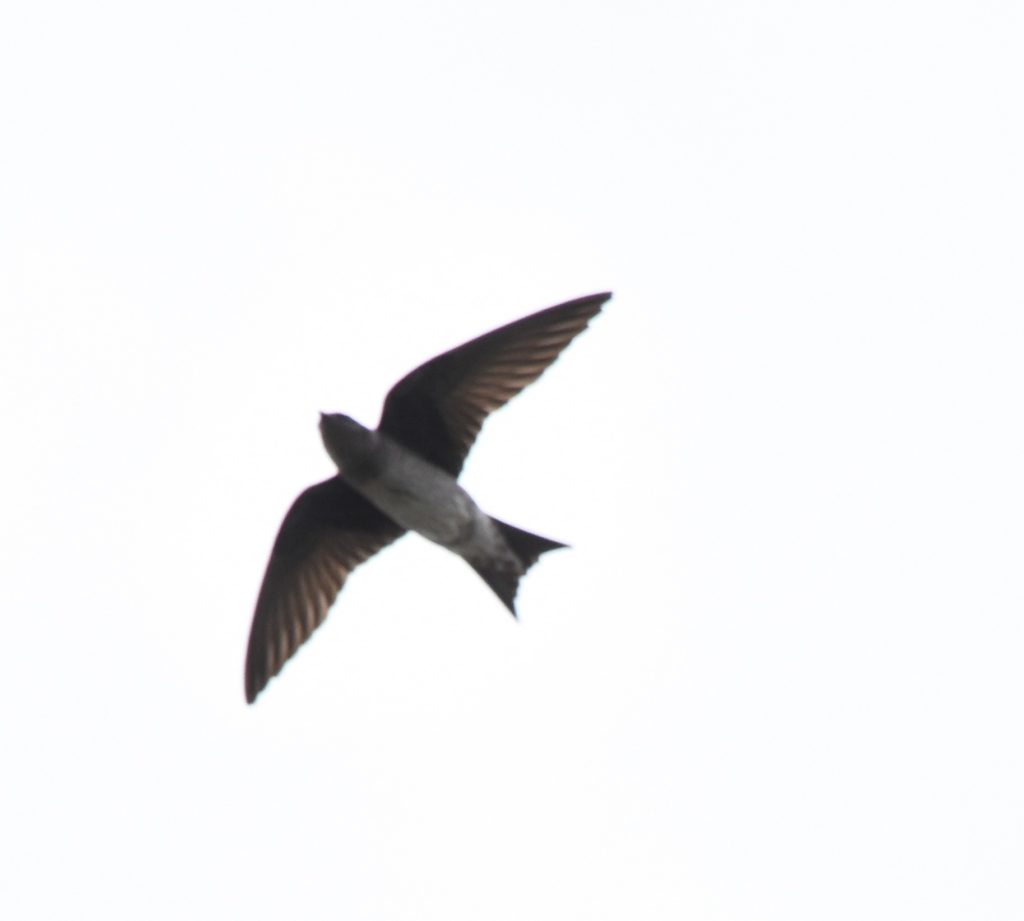
A nice last supper at a R&R Indian food restaurant wrapped up the trip. The list for the 6 days we all birded together was 162 species, with many lifers and great looks at most of them. No injuries, no one expressed much regret at birds missed, and I felt like the trip went really well, in significant part to participants who were just happy to get birding in a fabulous area, and in large part to the great trip Ken Brown, Bruce LaBar and I had together to help me get up to speed in the area.
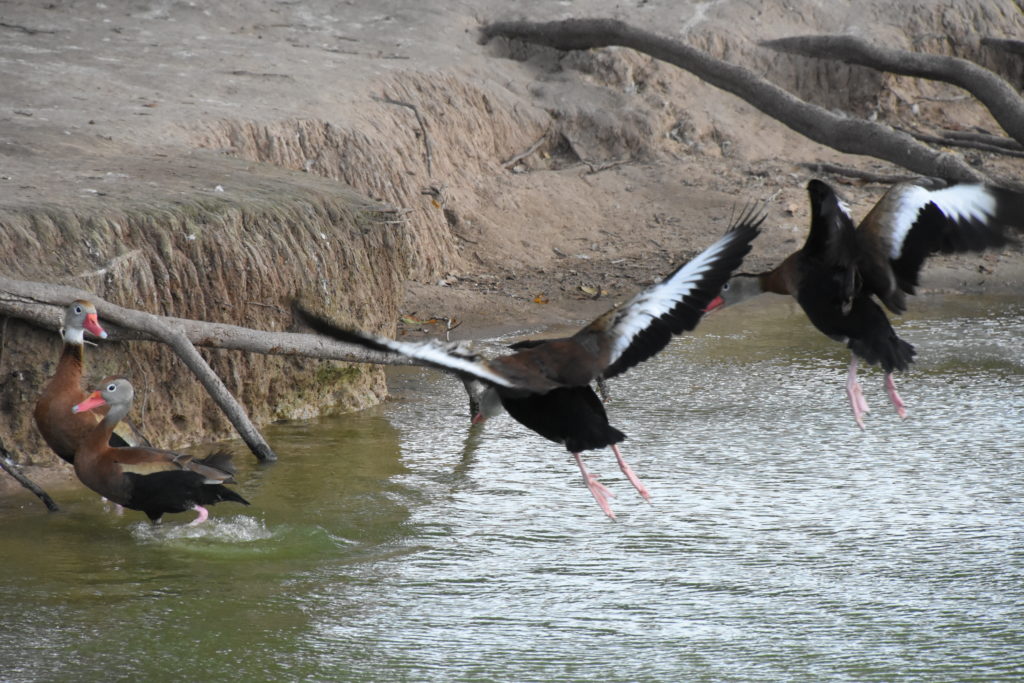
Shout outs to local experts like Mary Gustafson who several times helped me get out on chases for uncommon birds here (listen to her on The Bird Banter Podcast Episode #48 with Mary Gustafson) and other local and winter Texans who shared tips and birds generously.

Until next time. Good birding. Good day!
Ed, Ken and Bruce in the Lower Rio Grande Valley
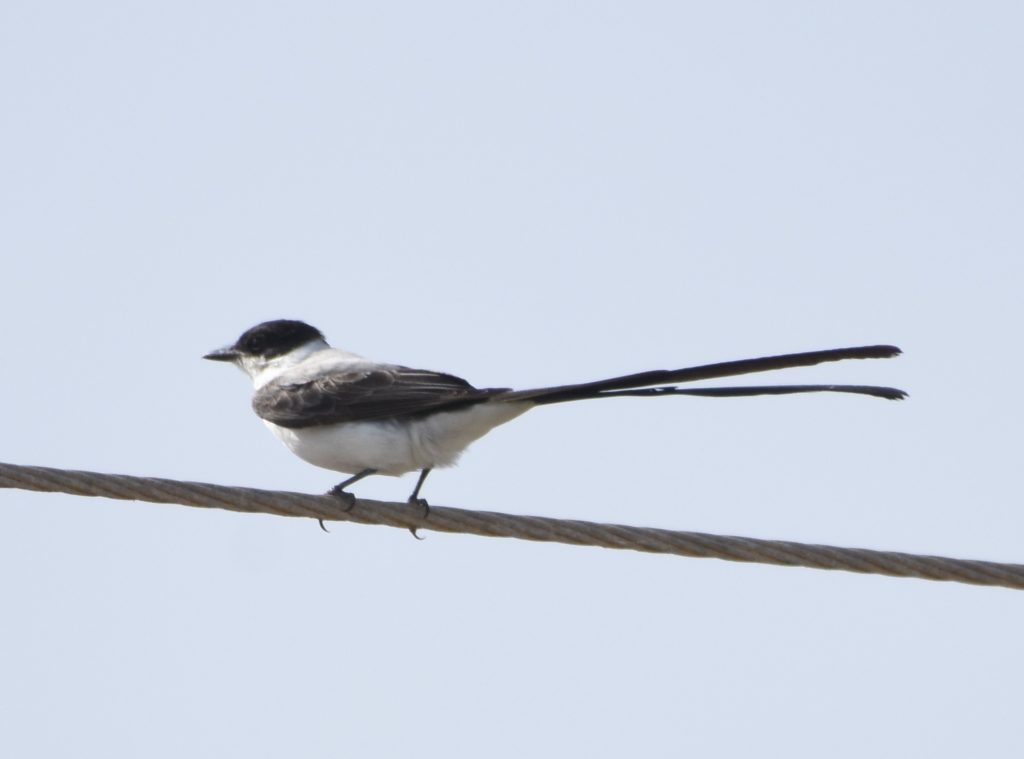
Ken Brown and Bruce LaBar joined me in McAllen, TX for a 9-day birding adventure, and headed back home yesterday. We had a great time, saw lots of birds, places and stuff, and overall rocked the valley. You can follow my birding notes most days on the Ed’s Birding Notes tab on the Bird Banter website. The guys were also gracious enough to record a podcast episode after our last full day of birding, and it is now published as episode #46 and you can listen where ever you get your podcast feeds, or on the Bird Banter website where there are links to Apple Podcasts, Stitcher, and Spotify feeds, or you can just listen right there.
Stay tuned, as today I met with Ryan Rodriguez, a 12-year old birder from McAllen and his Dad to record an episode. I had a blast meeting him, hope to get out birding with him while I’m here and plan on publishing that episode later this week.
You can find photos from this trip on my flickr album.
A bit over a week until the ABC contingent descends on the valley to see the specialty here and have fun birding together.


Good birding. Good day!


